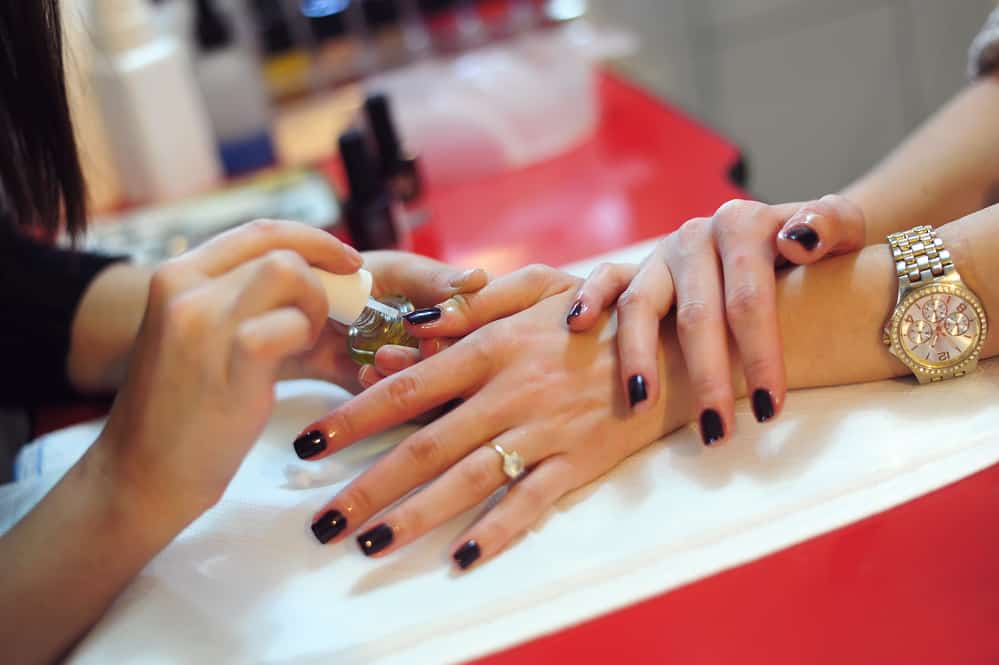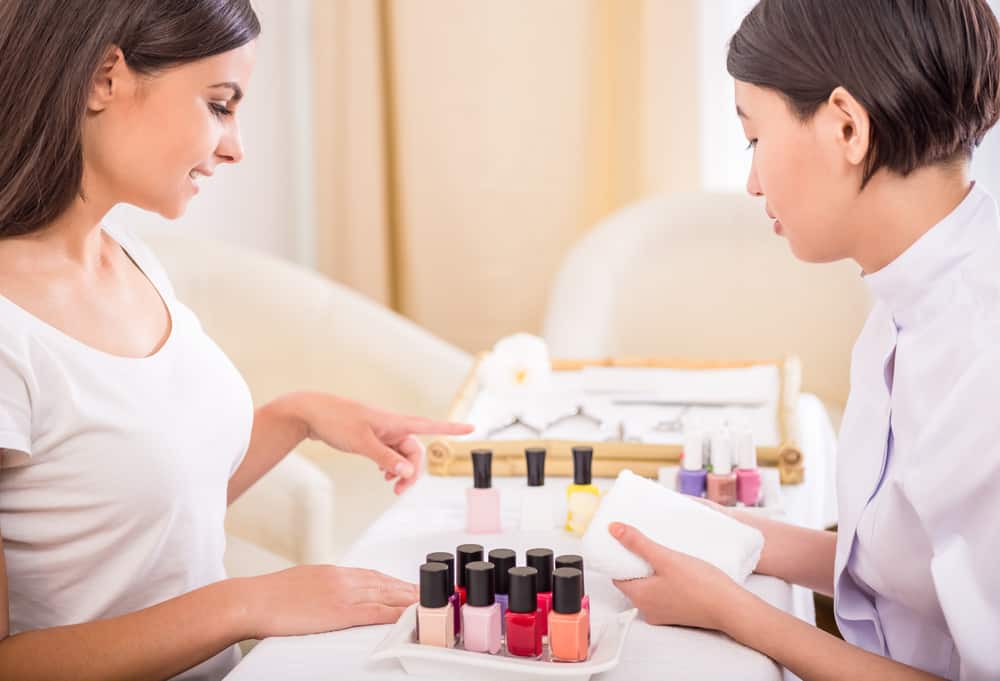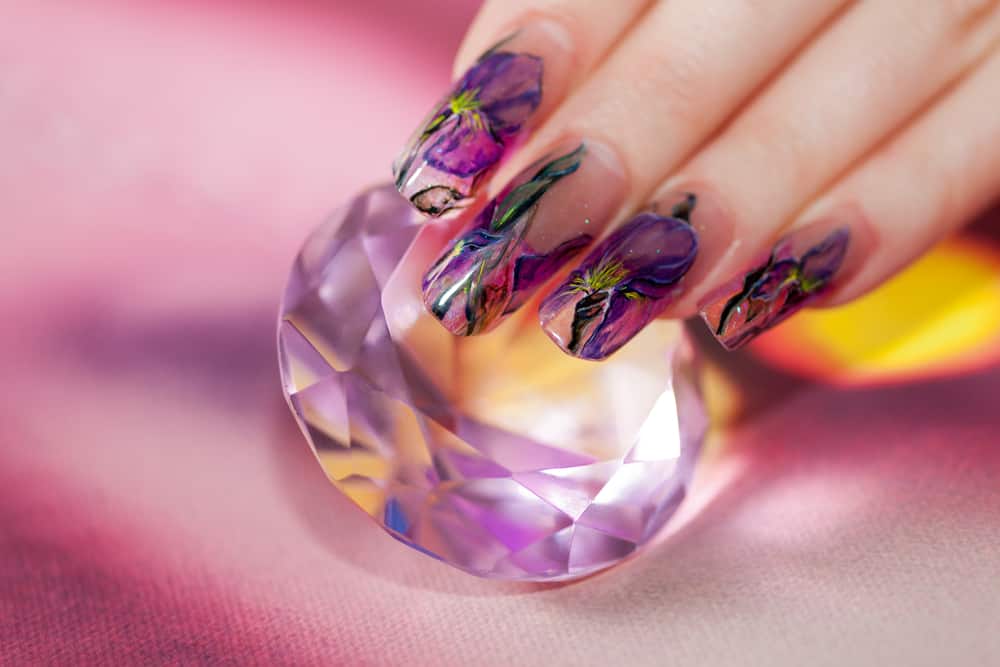
Slip solution is typically used with a system called Polygel or Gelish which is different from gel or acrylic.
This product can be used with any gel system.
It has a chemical composition all its own, and you’ll be introduced to it in this article.
Slip solution is an invention of convenience.
Let’s address it and the Polygel it’s used with, so you get a complete picture.
What Is Slip Solution For Nails?

Slip solution is used with gel manicure systems such as Polygel or Gelish as a way to make the gel smoother.
The Polygel tends to get a bit stringy, but once the Slip Solution is applied to the Polygel, it will spread out onto the nail more evenly.
The name of this product originates from the Slip that is used by professional potters who create clay art on a potter’s wheel.
The Slip liquid gives them the ability to slip their hands around the clay and mold it more easily.
For gel nails, slip solution will thin the consistency a bit so that the gel can be spread over the nail and shaped more easily.
What Are Polygel Nails?

Polygel is not like the gel nails you are accustomed to, and nor are they like acrylics in any way.
This is a revolutionary nail system that can easily be applied in a couple of different ways for superior results.
This is a nail system that is simple and halves the time and mess of the traditional gel or acrylic nail systems.
How Do I Use Slip Solution With A Gel Nail System?

- First, prepare the nail in the usual way by cleaning any dirt and oil off the nail. File and then buff them.
- Push the cuticle back, but not too far. You want to do it just enough for the nail gel not to overlap the skin. This is something that happens when people do their nails at home and then there is unnecessary irritation and lifting of the nail. We should always make sure to allow as little contact with the skin of the fingers as possible.
- After steps one and two are finished, you will need to get rid of the surface oils and possible debris that is left over. You can use rubbing alcohol to take that off. You might also use a conditioning oil. Just be sure to rub it in all the way until you don’t feel it anymore and wash your hands thoroughly with soap and water.
- Prepare whatever system you are using for the gel nails. Slip solution can be used with any system. For example, if you are using duo forms, now is the time that you would select the forms that fit each nail. If you are using this popular method at home, make sure that you carefully select the sizes for each nail.
- If you are using duo forms, make sure that the nail slips {forms} are a bit wider on the sides than the nail. This will prevent gaps after you’ve built the nail.
- Next, you will shape the nail on the form. Start with a pea-sized portion of the gel and place it on the middle portion of the form on your nail.
- Take your gel application brush and dip it into the slip solution. Proceed to spread the gel. Use more slip solution if you need to as you go along.
- Make sure the gel is thicker in the middle part of the nail and thinner on the edges.
- Apply the topcoat.
- Get the nail to the shape you want, and when you are sure it’s where it needs to be, then cure it under the lamp for the time specified on the label of your topcoat.
- Take the slip solution again and apply it uniformly to the top of the nail. This will ensure all the excess gel is smoothed out and off the nail.
- Cure them again quickly under the UV or LED lamp for 30 to 60 seconds and wipe any debris off with a blow dryer, paper towel, or a clean makeup brush.
What Else Can I Use For Slip Solution?

Isopropyl Alcohol 70% and non-acetone nail polish remover are the best substitutes.
Some gel nail kits come with Slip Solution, and some do not.
If you couldn’t get Slip Solution and the stores are sold out of isopropyl alcohol, as many have been, you can use non-acetone nail polish remover.
Remember that it must state “non-acetone” on its label.
It will say so on the front of the bottle or in the back.
Just look at the ingredients.
If acetone is listed there, you have the wrong type.
It’s easy enough to find the non-acetone nail polish remover in the drug store or the dollar store, and it should cost no more than one or two dollars.
You may ask why you wouldn’t use acetone as a solvent when that is precisely what it is.
It’s too strong, and it’s a solvent that is used to take acrylics and gels off.
It would attack the gel and weaken or disintegrate the gel.
You only want to make the gel thinner and easier to spread and to remove the excess, which are all the things Slip Solution does.
What Affects The Consistency Of Gel?

The ideal temperature to work with gel and Slip Solution is 60 to 71 degrees Fahrenheit.
Remember that the polish, gel, and Sip Solution are affected by the curing process.
This process uses UV and LED light.
When the product on your nail is exposed to the sun which gives off UV rays and heat, it will affect the product in some way.
Make sure you are keeping them out of your sunbathing routines in the summer, or at least, not subjecting them to the sun and heat for too long.
Most of the time, the people who are affected the most would be mobile manicurists who go from house to house and sit on porches or in garages for ventilation.
The product goes from an air-conditioned car to someone’s home or from public transport into yet another atmosphere.
This causes constant changes in its consistency.
The manicurist must take steps to protect their business by protecting their temperature-sensitive product.
The manicurist may choose slower setting gel products and Slip Solution.
This gives the manicurist time to work with the gel, and they have no issues in transit where most of the damage begins.
Temperature won’t destroy the effectiveness of the gel, but it will make it harder to work with.
It only takes a degree higher or lower to affect the gel’s viscosity.
If it’s too high, it becomes runny and too low, the gel will thicken.
Slip Solution should be kept on hand and well-stocked.
When the gel has frequent temperature fluctuations, it may also get stringy.
In that case, especially, Slip Solution may be used to gain the best results.
The manicurist must be sure to keep the product from prematurely curing.
This can be accomplished by looking at where they work.
They should keep desk lamps and overhead lamps away from the product.
They should also keep brushes and containers that are open away from light sources that project heat.
Can I Use A Slip Solution With The Different Gel Types?

Yes, you can use Slip Solution with any of the three gel types that are in use today.
You must understand that Slip Solution is not a monomer.
It has no chemical properties as such and will only be used as a solution to make the gel more pliable to work with easily.
What Are The Different Gel Types?
1. Hard Gel

Hard gel is used to give nails extra length and to strengthen existing natural nails.
This gel is thick.
The hard gel application is used for all lengths and is applied by being pulled down the nail from base to tip with a special gel application brush.
They last around three weeks to one month, and they can be removed by filing.
The cost of hard gel sets typically runs around $80.
2. Soft Gel

Soft gel is used for nail strengthening and growth.
It’s best for medium to short nails.
It’s removed by soaking in acetone.
It’s applied with a brush by pulling.
These nails last two weeks to one month and cost around $45.
3. Gel Polish

Gel polish is a longer-lasting polish than others as it’s more durable.
It’s great for mid to short lengths and also for natural nails.
It’s removed with acetone.
Applied with a brush by brushing on and not pulling like the fill gel, this treatment will last from two to three weeks and cost about $45.
Will Gel Overlay Help Me Grow My Nails?

Yes, a gel overlay can help you to grow your own nails by adding strength and protection to your existing nails.
The whole purpose is to give the nails a structured clean look.
It adds no length, so it doesn’t need to be built.
Slip Solution may also be used here if the gel is too thick or hard to work with on a nail that’s maybe too short or in an odd shape.
A gel overlay is going to give a shape to the existing nail to create a neat, manicured look.
At the same time, the nail can grow beneath the gel while protecting it from chipping, splitting, peeling, or breaking.
All the things that a natural nail can endure while trying to grow won’t happen.
The gel overlay does have to be maintained much like an artificial nail.
As the natural nail grows out beneath the gel overlay, the half-moons at the base of the natural nail will become exposed.
This is how you know you need an appointment.
The nail tech will either fill the nail and do another coat of overlay or will remove the old overlay and give you a fresh coat.
This is what is typical.
The nail tech will examine your nails and look at the color and shape and how they’re growing.
They will then decide what action to take.
It’s always best to get a fresh manicure for several reasons.
Once they remove the gel overlay with acetone, they will thoroughly clean the natural nails.
After all the gel, color, and debris are cleaned away, they will then work on the cuticles, taking away any dead skin and hangnails.
The tips may have to be trimmed too if there are brittle spots.
It may take time for your nails to strengthen themselves.
You can do this through vitamins and proper nutrition.
The nail tech will examine the nails for any discoloration which could mean a reaction to the gel or fungus which must be addressed immediately.
If this is the case, they may suggest that you leave any nail treatment off for a month or two and get antifungal treatment from the doctor to clear it up.
Once you are cleared, then the overlay can take place again.
The nail tech will also inspect your cuticles and surrounding skin for any irritation.
Once the nails are at the length you would like them, you can either continue with a light gel overlay or gel polish just to protect your natural nail.
You would be expected to get regular professional manicures to keep them long and healthy.
In Conclusion

Slip Solution can be the difference between a great gel nail manicure or a sticky, shapeless one.
Gels are quite versatile and are the only nail treatment system to suit every taste and need.
If you’re a manicurist, you should have Slip Solution in your arsenal of tools at all times.
You’ll need it when you travel and give service in different temperatures.
Refer to the types of gel nails in this article to be sure you are getting the correct one.
If you’re doing it yourself at home and can’t get a Slip Solution or it’s not in your budget at this time, then remember you can use Isopropyl alcohol at 70% or non-acetone nail polish remover—emphasis on the non-acetone part because that’s important.
If you’re someone who wants to DIY your own gel nails, the Slip Solution is a must as the amateur home manicurist is bound to need its services.
Can I use the slip solution inside of my gel. I use apres